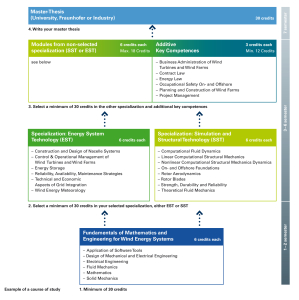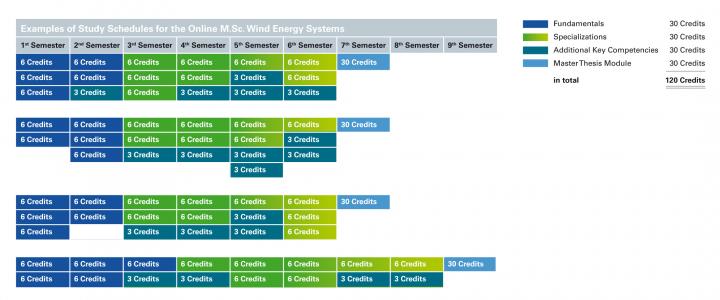
Program Overview & Curriculum
Type of program | Part-time online master |
|---|---|
University of Kassel | Department of Civil and Environmental Engineering (Bauingenieur- und Umweltingenieurwesen) |
Final degree | Master of Science (M. Sc.) |
Language | English |
Standard period of study | 7 semesters |
Total credits | 120 credits |
Study organization | See picture below |
Program start | Every year in mid-October (winter semester) |
Application & deadline | Application period for international students: December 1 - September 1 |
Tuition fees | 14,000 Euros (independent of study duration) |
Semester fees | Ca. 175 Euros each semester |
Payment method | Bank transfer |
Program management | University of Kassel & |
Partner institution | Fraunhofer Institute for Energy Economics and Energy Systems Technology (Fraunhofer IEE) |
Career opportunities | |
Accreditation | German Accreditation Council (Stiftung Akkreditierungsrat) |
*see Examination Regulation §7 (7)
Curriculum
The Online M.Sc. Wind Energy Systems consists of four components making up for 30 credits each. All students start with the Fundamentals-modules which lie the groundwork for the upcoming specializing courses. They teach you the basics about the functioning of the electrical and mechanical components of a wind turbine as well as the electrical engineering behind it. Students further learn how to use various simulation programs (including MATLAB, OPEN FOAM) and how to model the flows in wind energy systems. As they will earn you 6 credits each, you only will need to study five out of the six Fundamentals-modules offered.
The master program offers two specialization paths that build on the foundation laid in the fundamental modules. As a student you are free to choose both the specialization and the courses within it. The first specialization Energy System Technology (EST) imparts knowledge of the energy system technologies of a wind turbine. This includes, for example, the design of a nacelle system and the control and the operational management of a wind turbine. In addition, it offers learnings beyond the technology of a wind turbine, like the grid integration of renewable energies and their storage as well as energy meteorology.
Within the second specialization Simulation and Structural Technology of Wind Energy Systems (SST), students learn about the design and structure of rotor blades as well as the material behavior of soils in order to determine the appropriate locations for a wind turbine. You will learn how to identify the flow field of a wind turbine and analyze the aerodynamic processes of wind turbines.
The variety of the program is further expressed in various non-engineering subjects – the Key Competencies-modules. They provide students with the management skills needed to build wind farms and wind parks. The study is rounded off with legal knowledge taught in elective modules such as Contract Law and Energy Law.
Within this study component you are allowed to take courses from the key competencies as well as from the other specialization that you have not selected.
In the end, you will crown your studies with a master thesis with a scope of 30 credits.
The broad range of courses offered at master's level entitles students to pursue a doctorate after graduation. As many subjects have a high university standard, graduates are suited to pursue a career in research. However, the core of the education is to train the students for the wind industry job market. Classic occupational fields are the R&E departments of a wind power manufacturer and at a planner and project developer office.

